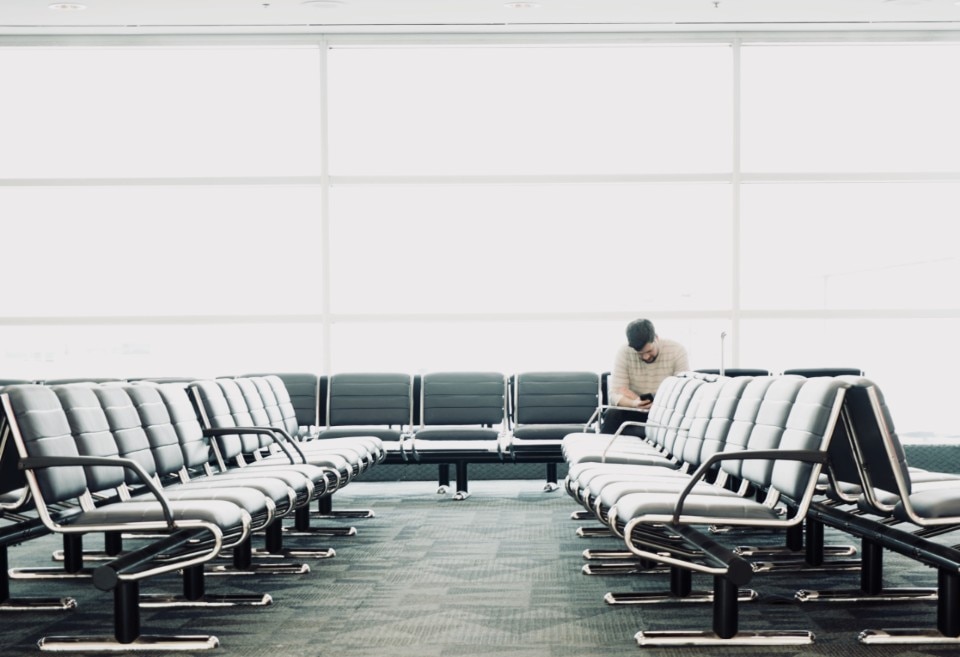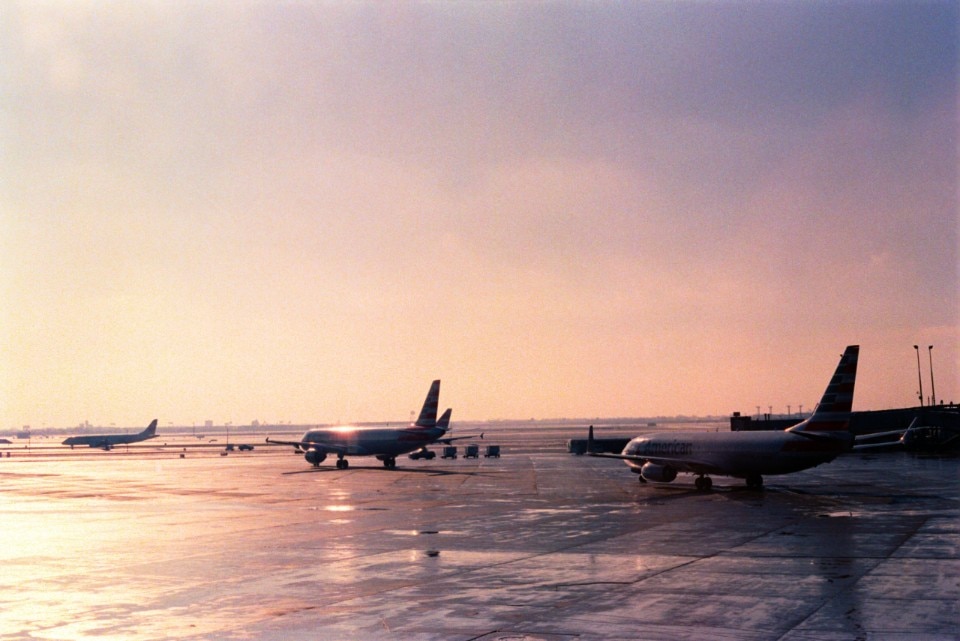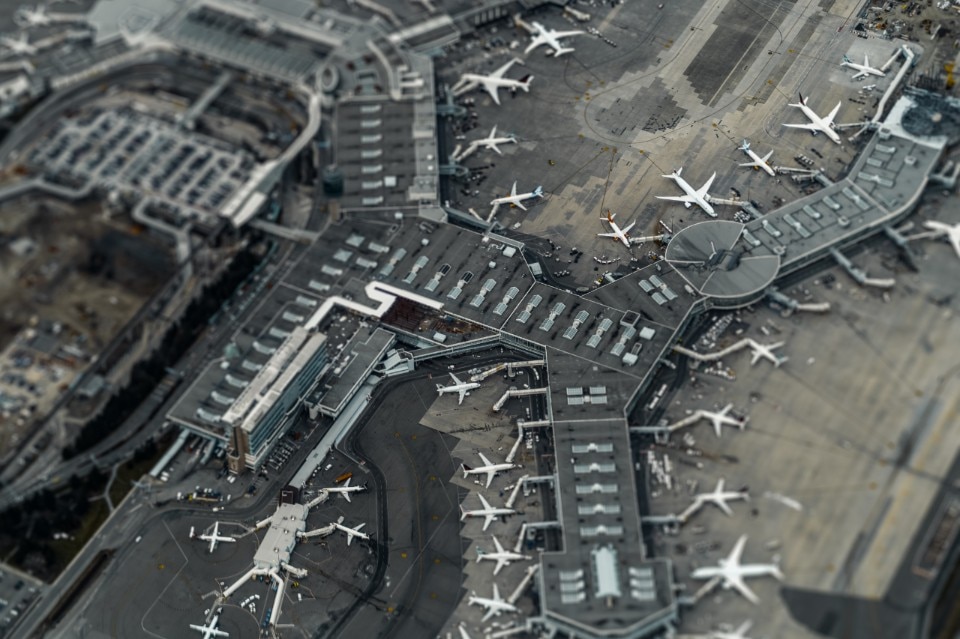In collaboration with Giulio De Carli, founding partner of the design and strategic consulting firm One Works and speaker at domusforum 2020
From that somewhat surreal parenthesis that was the summer holidays in the year of Covid, a plastic representation of what (perhaps) travelling by plane in the near future will be like has emerged in all its complexity.
The issue that most stands out is obviously that of healthcare, with all the implications and pitfalls this carries with it on a practical, legal and social level.
The odyssey of travellers between thermoscanners, masks and forced routes, however, is only one of the many challenges that the airport sector is facing in this time of passage, and probably not the most complicated.
Or rather, it is only the first stage of an obstacle course that in a way leads to the future, trying to return to something (not too) similar to the past. That is, when air travel symbolized - even materialized - the globalized Anthropocene.
Flight transport, the world’s nerve system
While on a geopolitical level, globalisation is a matter of commercial routes and therefore of maritime traffic, humans travel by air, carrying with them the ideas and visions that interpret and shape reality. If maritime routes are seen as the arteries of the global organism, air routes are its nerve system.
Various research projects have shown for example that in the United States, increases in production, salaries and income, the number of degree graduatesand highly technological industry are all closely related to the number of passengers per capita.
The great cities of the past were initially built around ports, and then around railway stations, and in today’s world the role of access point for prosperity has been taken by airports.
It is no coincidence that structural modernising and an all-round improvement of airport services are central matters on the agendas of economically developed countries, while developing nations and those seeking full acceptance as part of the global elite are investing in new airports, aware that these are central to a concrete policy of social and economic development.
While in the past the most important hubs were in the United States and Europe, the last decade has seen a large quantity of new mega-airports springing up in the Middle-East and Asia, and air traffic is (was?) shifting towards the Orient, following the demographic and economic growth that is accompanying the new lifestyle in that part of the world.
Before the anti-infection measures, approximately four billion passengers flew around the world every year, and estimates predicted a doubling over the next two decades.
In short, it is impossible to imagine that the world economy can get back on track definitively without air traffic returning at least close to pre-crisis levels.
According to estimates by IATA - The International Air Transport Association - the recovery of passenger transport to pre-Covid levels will have to wait until at least 2024 and an almost complete recovery of short-haul transport is expected not before 2023. As for 2020, the annus horribilis is expected to close with a 55% drop compared to the previous year.
With regard to air transport alone, IATA estimates a global deficit of $419 billion and as many as seven million jobs at risk, including induced jobs.
These forecasts are knee-shaking and yet imply two elements that are not entirely granted: (a) that the virus will be quickly defeated and (b) that air transport with its associated and related activities will be able to reform itself and be reborn.
This is an obligatory opportunity for a multidisciplinary rethinking of airports and, over the coming months, a change in gear that we previously imagined would take decades.
This is why, in interpreting a future model for airports, a true paradigm shift is essential: a switch from the centrality of physical architecture to that of digital, or rather to the development of the first on the basis of the second. A revolution in terms of methods and instruments that, despite being forecast for some time and already under way in some areas, will undoubtedly see an acceleration on a global scale due to the current crisis.
One thing seems certain: once the emergency is over – and it may last as long as a few years, characterised by peak periods – it will be necessary to protect ourselves from the risk of future pandemics.

The role of technology
We could find ourselves living in a constant on-off condition, with necessary flexibility between an active set-up in more tranquil periods and a situation in which restrictions can once more be applied without suffering significant setbacks.
The health emergency has simply accelerated processes that were already in motion, bringing us closer to a tomorrow that in some way we could already see.
In the near future, security checks and passenger health screening will be carried out via biometric sensors. Passengers and luggage will be recognised by scanners that will render physical document checks obsolete.
Everything will have a digital label: people, luggage and freight. All of these will be traceable for the entire journey, whatever the method of transport used before and after the flight. This means that travel visas and customs controls can be handled pre-flight, with significant savings in time in the airport. Furthermore, luggage drop-off and reclaim will be available in areas most convenient for the passenger, for example in a bus terminal or train station or, even better, the final destination.
Efficiency will be guaranteed by predictive artificial intelligence algorithms. The data gathered from airport and airline sensors via 5G will be processed to forecast passenger flows, rationalise resources and reduce the time necessary for operations: from cleaning and working shifts, taxi and train schedules, to aircraft maintenance, everything will be carried out on a just in time basis.
With more advanced versions of current chatbots, the digital assistants of the future will be able to recommend local attractions, list nearby hotels and transport solutions to reach the city centre or, more simply, indicate the way to a boarding gate.
The future of airports lies in integrated and highly intelligent operativity that is capable of offering a trouble-free travel experience for passengers and the possibility for airlines to rationalise expenses and maximise resources. Protocols such as blockchains will play a key role in fostering passengers’ trust in digital interfaces.

A new relationship with the environment and the challenge of complexity
One of the responsibilities that this pandemic has forced us to face up to is without a doubt that towards the environment and nature, which we have seen rapidly repossess space, almost as a kind of warning for the future. We need to maintain and pursue the benefits that we involuntarily enjoyed in the past month: a reduction in emissions and in the ozone hole, better air quality in cities, clearer water and sea life momentarily out of danger. First of all we need to make sure that the mistakes of the past are not repeated, hoping that this increased level of awareness deriving from the crisis convinces the global elite that real sustainability policies are not an option, but the only possible path to take.
Modernizations, expansions and renovations will have to be evaluated and, above all, each new project will have to imply a different relationship with the environment, both through the use of new technologies and through a rapid implementation of the various eco-friendly architecture protocols that have been studied for some time.
Finally, there is the delicate matter of privacy, which risks creating conflict with the need to trace traveller behaviour in order to prepare new measures for containing both the present epidemic and any that the future holds.
It is necessary to make use of tracking technology against the coronavirus, but in order to maintain democracy we need to actively make sure that we don’t suddenly find ourselves in a society characterised by mass surveillance. This leads to the need to involve not only legal experts but also intellectuals and philosophers who can contribute with their ideas to redesigning a paradigm that places human beings at the centre of considerations and avoids any drifting towards authoritarianism or technocracy.
Finally, it is important that the desired turn-around of the airport sector does not remain an isolated case in the landscape of large transport infrastructures and beyond. The dynamics of the global world on the one hand require the integration of systems but on the other hand make knowledge and methods available by osmosis.
The hope is therefore that the technological, sustainable and flexible airport can become the gold standard of the next infrastructure paradigm.


